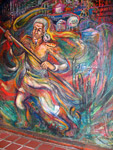Gabriel Bracho – forerunner of the Bolivarian revolution
V. Demenina
Photo: R. Sapozhnikov
January 2007
|
The town of Los Puertos de Altagracia is located at the Eastern bank of Lake Maracaibo, opposite the capital of the same name of the petroleum state Zulia.
The most remarkable place in Los Puertos de Altagracia is a Home museum of the muralist artist Gabriel Bracho. The museum was opened for amateurs of art even in May 1977, when the artist was still alive, and since that time it has not phased out its noble mission to popularize realistic for a single day, social oriented truly humanistic art. All these epithets concern the works of Bracho himself, who stands in one line with great Mexican muralists - Siqueiros, Orozco and Rivera.
Bracho used to live and work at the epoch, when those artists-realists having active views for life, were pressed from all directions by bourgeois, commercially profitable art that used to be presented (and is being presented nowadays) as «the artistic equivalent of scientific and technological advance». For Bracho, this purposeful dehumanization of art and making it senseless, equals to publicly committed crime against human civilization.
The attitude in Venezuela towards the exhibition devoted to the 50th anniversary of Bracho activity is very indicative. It was practically ignored by the mass media of the country! The Venezuelan bourgeois elite was crowding in the halls of the Modern art museum among anti-aesthetically beautiful structures of the American Rauschenberg, the only view of which scared inexperienced in formalism children. That is what the political engagement of mass media, which has confused the Venezuelans, brought to!
Is it possible that even nowadays, in the Bolivarian Venezuela, somebody is interested in «preservation» of Gabriel Bracho and his creative works at the periphery of social and cultural battles? The silence conspiracy is till surrounding the artist.
Few words about the life trajectory of Gabriel Bracho. He was born on May 25 1915 in Los Puertos de Altagracia in the family of telegraphist. Since his childhood he used to reveal interst to drawing and painting. His caricatures for his fellow-students were his first success. He used to study painting in Maracaibo, in Caracas, Sanitago de Chile, Mexico, Paris and New-York. Bracho was greatly influenced by David Alfaro Siqueiros, to whom the Venezuelan assisted in making the fresco «Death to the Invader!» in the provincial Chillan (Chile).
The artistic heritage of Bracho includes dozens of murals in Venezuela, hundreds of easel paintings and graphic works scattered among private and museum collections of the world. One of his murals - «Boyaca» decorates the walls of the presidential palace Miraflores. A unique, made by him stained-glass window can be seen in the Ministry of Defence of Venezuela. This is a building dome of 234 square meters.
But probably the most favourite piece of work of the artist is his mural of 120 square meters «Los Puertos and petroleum», on which the artist worked in several stages and completed not long before his death on March 6, 1995. This fresco is situated in the inner yard of his Home museum. It tells us about the life of Los Puertos de Altagracia staring from the colonial times till present time with the history of Venezuela at the background. Miranda, Bolivar and other heroes-liberators are among the characters of the mural.
The folklore motives are also interesting: the procession of St. Virgin of Altagracia, festival in honour of a black saint San Benito. Subject of consumer attitude towards the lake of Maracaibo is interlaced here – beer cans, bottles, empty petroleum barrels covering its bottom.
As if jeering at the activity of the artists of Rauschenberg kind, Bracho incorporated into the mural entourage the metal barrel, on the bottom of which he placed the portraits of his ideological opponents – famous Venezuelan politicians Carlos Rangel and Sofia Imber, who, according to Bracho, represented the interests of the world imperialism in Venezuela.
The honourable place in the portrait gallery is occupied by a Chilean poet Pablo Neruda, whose poetry Bracho has always admired.
One can't help mentioning that the mural in Altagracia was made by Bracho at his own cost. A decade of walking around «functionaries offices» in search of financing did not yield any fruit. Neither local authorities that pontificated their «love to the art of little motherland» came down with money.
Instead, the solemn unveiling of the mural has become a real holiday for the residents of Puertos de Altagracia. Almost everyone has come! As a relic Bracho used to keep the album with pictures, made at that memorial day: here he is «heading» the orchestra on the way to the venue, here – padre sanctifies the mural, here his friends, who came from Caracas, and childhood and youth friends from Altagracia.
After the death of Bracho, Laura Cardozo de Añez is heading the work of the Home museum. According to her, all efforts of the recent years to get financial assistance for the museum activity, its repair, and – the most important – restoration of perishing from heat and humidity works of Bracho and paintings of other artists collected in the museum, turned out to be fruitless. The Bolivarian cultural authorities might be now engaged in more dimensioned tasks. Gabriel Bracho again is shifted to the periphery of «official priorities».
 |
One cannot but recollect, that it was Gabriel Bracho, who, as if foreseeing the present changes in Venezuela, used to say: «Hope has not died yet. The country will revive through the ideals of Simon Bolivar and Francisco de Miranda, who are aroused every hundred years along with awakening of the people»...
|
|



